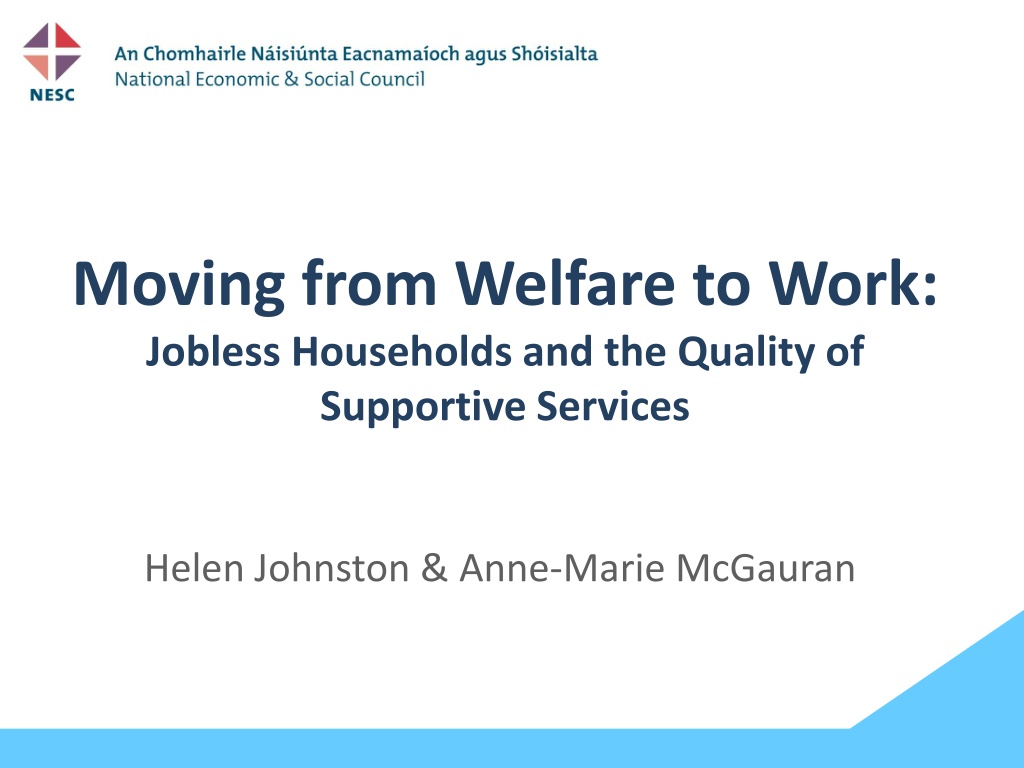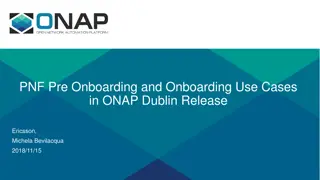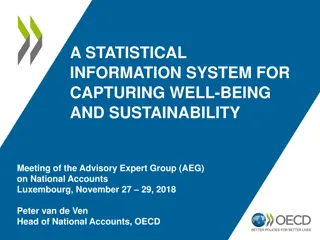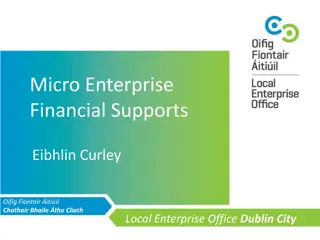Understanding Household Joblessness: Insights from a Study in Dublin
This study delves into the challenges faced by jobless households in a disadvantaged suburb of Dublin, exploring the impact of household joblessness on poverty, children, and the state. It highlights key themes such as employment support services, education, training, and the role of institutions in service provision. The findings emphasize the broader perspective of household joblessness beyond mere unemployment, considering factors like caregiving responsibilities, disability, and lone parenthood. The study sheds light on the unique characteristics and experiences of households grappling with joblessness, pointing towards the need for comprehensive support systems to facilitate their transition from welfare to work.
Download Presentation

Please find below an Image/Link to download the presentation.
The content on the website is provided AS IS for your information and personal use only. It may not be sold, licensed, or shared on other websites without obtaining consent from the author. Download presentation by click this link. If you encounter any issues during the download, it is possible that the publisher has removed the file from their server.
E N D
Presentation Transcript
Moving from Welfare to Work: Jobless Households and the Quality of Supportive Services Helen Johnston & Anne-Marie McGauran
Outline of Presentation Why focus on jobless households? About the NESC Study Experience of household joblessness Findings the key themes Engagement with employment support services Employment opportunities Moving from welfare to work Education and training The role of institutions in service provision Conclusions
Why focus on jobless households Household joblessness is high in Ireland People in jobless households have a high risk of poverty Household joblessness has a long and lasting impact on children Household joblessness is a significant cost to the state Jobless households are households where no-one is working or there is only marginal attachment to the labour force (sometimes referred to as low work intensity households)
Household Joblessness is distinct from Unemployment Broader than unemployment Includes caring for home & family, people with disability, carers, lone parents Considers all the adults under 60 in a household
NESC Study: in a Disadvantaged Suburb of Dublin The area had characteristics of jobless households, which are: 92 Interviews with: 33 jobless households (34 people) 16 local services 11 county/regional services 11 local employers 12 government departments / agencies 9 national stakeholders Higher levels of unemployment Lower education levels Higher rates of disability Households more likely to contain children More likely to be headed by a lone parent More likely to be in the manual social class More likely to be renting accommodation
Description of Household Interviewees Education Levels No formal qualifications 9 Junior certificate - 2 Leaving certificate 4 Apprenticeship 3 FETAC level 5/6 4 Degree 4 Literacy difficulties/dyslexia 7 Housing Own home 7 (6 in mortgage arrears) Council house 11 Emergency accommodation 3 Sharing with relatives 10 All attached high value to education
Description of Household Interviewees Labour market experience None 5 refugees, Travellers, young people Low skilled jobs 20 Medium skilled jobs 10 High skilled jobs 8 4 moved from low skill to high skill 4 (all African migrants) moved from high skill to low skill Reasons for unemployment The economic crash 10 Having a family 7 (all women) Ill health of self/family member 6 Other factors, including discrimination 7 (Travellers/African migrants) Rent supplement rules 2 More than 1 reason - 17
Social Welfare Payments and Job Search Payment Type Job Search 3 2 3 4 12 3 15 5 4 5 4 6 Jobseekers Payment Unemployment Scheme Qualified adult* Disability/invalidity payment Carer's Allowance One Parent Familiy Payment/JST Other/unknown Have to look & looking Don't have to look & not looking Don't have to look, but looking Don't have to look, but would like a job Have to look but given up * Qualified adult = the adult dependent of a person receiving a social welfare payment
Key Findings Households Positive Aspects The vast majority wanted a paid job Benefits of some education and training courses The value of employment support schemes The benefits of living in local authority housing The support of family and friends, and the wider community The value of volunteering Resilience, ambition, hope were evident in many interviewees
Key Themes Engagement with Employment Support Services Three key services - Changes since 2012: Changes since 2012: Activation -Intreo case officers who try to find clients training or job opportunities -Personal progression plans (PPPs) agreed between the client and the case officer -But not everyone aware of PPPs Sanctions for not engaging with activation -Low rate of application of sanctions -But threat of application felt -Can help promote engagement Engagement with jobless households: Engagement: Eligibility -Criteria vary -Qualified adults & some NEETS* usually not eligible for activation supports Information -Complex system to understand -Jobseekers can be fearful to engage with Intreo in case their payment is cut Depth of Engagement -Is it speed dating rather than in-depth career advice? -Are clients met where they re at ? * NEETS = Young people not in employment, education or training Activation - Case officers - Personal progression plans - But not everyone aware of these Sanctions - Low rate of application - But threat of application felt - Can help promote engagement Eligibility - Criteria vary - Qualified adults & some NEETS usually not eligible for activation supports Information - Complex system to understand - Jobseekers can be fearful to engage with Intreo in case their payment is cut Depth of Engagement - Is it speed dating rather than in-depth career advice? - Are clients met where they re at ?
Key Themes Engagement of Employment Support Services with Employers Strongest by , weakest by Issues around data that can be shared with employers, and speed of responsiveness Not all training providers engaged comprehensively with employers
Key Themes Employment Opportunities Recruitment processes: Types of employees sought: Motivated, good work ethic, good inter-personal skills Particular qualifications were sometimes sought Diverse and changing, ranging from online to word-of-mouth Dropping in CVs not effective Those with poor IT skills/access not well equipped for online recruitment
Key Themes Employment Issues Self-employment: Flexible hours: Some sectors offered mainly flexible hours This led to unpredictable pay, and was problematic for main household income earners Combining irregular hours with FIS/Jobseekers Allowance was problematic for main income earners, & employers Some interviewees had unsuccessfully tried to set up their own business Most lacked the finance to do so Some bogus self-employment
Key Themes Moving from welfare to work (1) Challenges Some interviewees very far from the labour market Literacy difficulties, discrimination, trauma, addiction Some interviewees closer to the labour market but other issues Lack of confidence or motivation Mental health difficulties Rules of payment Difficult to find training/employment which is below the number of hours a welfare recipient is allowed to train/work per week Extent to which income from work replaces welfare income Minimum wage employment does not always cover the costs of a family with a number of dependents This issue is aggravated when working hours are uncertain Costs of housing, childcare and medical expenses a factor
Key Themes Moving from welfare to work (2) Housing - Cost of housing can be a barrier, especially those in private rented accommodation - HAP (Housing Assistance Payment) will help but supply of housing an issue Childcare - Affordable, accessible childcare required - After-school care often not available; nor during school holidays Medical costs - Costs of medical treatment an issue for some in taking up a job - Can retain medical card for up to 3 years but not everyone knows this - Longer access to a medical card may be required for chronic or recurring conditions Transport & IT - Transport to jobs can be expensive on a low income - Lack of access to IT can limit people s capacity to apply for jobs online, to take up training, and to connect to other online services
Key Themes Moving from welfare to work (3) Supports available to support the transition from welfare to work Family Income Supplement (now Working Family Payment) Back to Work Family Dividend HAP (Housing Assistance Payment) Affordable Childcare Scheme Retention of the medical card for 3 years Awareness of some of these supports low Can be delays in processing applications Uncertainty about final income can make people fearful of making the transition to come off welfare Employment Support Programmes can help provide work experience For example, CE, T s, (JobBridge now closed) But not always well linked to employment opportunities
Key Themes Education and Training (1) Education Low educational levels, and in some cases literacy difficulties, puts people at a disadvantage when competing for jobs Early school leaving remains an issue in disadvantaged areas, related to Lack of parental engagement and capacity Overly strict school disciplinary policies (in a small number of schools) Lack of role models among the teaching staff Lack of support for mental health difficulties Curriculum that some find difficult to engage with Attraction of a job, even if low paid Low status of further education and training (compared to higher education) Rates of lifelong learning are low, particularly for low skilled
Key Themes Education and Training (2) Training Training offered to nearly all jobseekers via Intreo Complex eligibility criteria, so that some people who wish to do this training do not meet the criteria Choice some interviewees went on courses they expressed an interest in; others felt sent on courses, i.e. they had to go or they could have their payment cut Limited supports to help with the costs of attending some courses Reports of not enough places on some sought after courses Patchy career guidance availability
Key Themes The Role of Institutions in Service Provision Ethos The ethos & values of an institution influence how it is perceived by those who engage with it Trust needs to be built to ensure that people engage effectively with services Supports which are tailored to people s needs Tailored supports are key to help more vulnerable groups to progress, e.g. Travellers, African migrants, lone parents, those with literacy difficulties, etc Some new services are tailored to particular circumstances, such as Housing Assistance Payment, Affordable Childcare Scheme Implementation & Co-ordination Action Plans, consultation with service users, and good outcome measurement all assist implementation Competitive tendering can reduce co-operation between services Good co-ordination requires dedicated time, staff & funds; and buy-in from stakeholders Funding is important, but must be used effectively for good outcomes
Key Barriers and Enablers in Transitioning from Welfare to Work
Conclusions Key Messages (1) The social welfare system and employment support system is generally supportive: It keeps people out of income poverty It tries to understand the needs of jobseekers It is more benign than in some other countries However: There is a lack of trust in Intreo People find it difficult to get information on the options open to them At times, people feel they have no choice on activation/training options offered It can be hard for vulnerable jobseekers to engage Better feedback measures are needed
Conclusions Key Messages (2) There is a need to: Develop a stronger focus on households Continue work to expand activation supports to qualified adults, people with a disability & carers who wish to work, etc Co-ordinate better Create better links to employers Provide better links between services Ensure all the supports necessary to move from welfare to work are available Provide resources for co-ordination Increase the intensity of support Provide more intensive support (e.g. in literacy education) to ensure effective outcomes, particularly for those most distant from the labour market
Conclusions Model of Activation Supports required for vulnerable groups: Vulnerable groups include lone parents people with a disability those with literacy difficulties, poor English, no work experience or contacts, a history of addiction or time in prison Vulnerable groups need supports tailored to their circumstances, e.g. Activation into part-time work Childcare, literacy supports Actions to tackle discrimination Particular supports for people with a disability The critical role of case officers in Intreo: Case officers need time to engage with clients Trust between clients and case officers needs to be fostered The most disadvantaged clients are likely to benefit from working with the most experienced & qualified case officers Case officers need good training to ensure they are aware of all options for clients in a complex system Managers have a key role in informing and training their staff
Conclusions Need for Tailored Services Some services tailored to the particular circumstances of families/individuals are already available, e.g. HAP, Affordable Childcare Scheme. However, The intensity of services could be increased More flexibility is needed at local level to tailor services to people s needs Services need to bridge gaps which are problematic for vulnerable groups Care Housing More public housing, and additional affordable private sector accommodation, is needed Transport & IT Support with public transport costs could help people move from welfare to work Transport allowances for trainees need to be increased to cover the actual costs of transport IT is expensive for those on welfare. Services need to be accessible for those without internet access, and/or IT support needs to be made available to them The Affordable Childcare Scheme is positive, but there is limited after-school care, and few childminders can avail of it. Work needs to continue to address these shortcomings. Greater flexibility is needed to support carers to take part in training & part-time work where they wish to Health The fact that the medical card can be kept for 3 years after leaving welfare needs to be promoted more widely It would be useful for those with an ongoing illness to retain the medical card for the duration of the illness, to reduce the disincentive to take up work Timely access to mental health supports is important
Conclusions: Welfare to work supports, secondary benefits and income supports Supports exist to help people move from welfare to work, e.g. Working Family Payment (previously FIS), HAP, Affordable Childcare Scheme, etc. However: For people with children, and/or in precarious employment, these supports may not provide enough certainty to take the risk of moving into work To facilitate more parents to move into employment, it would be useful to taper benefit withdrawals so that there is better alignment between these and the income that can be gained from paid work Timely assessment and payment of income supports and secondary benefits is crucial for those on low incomes with no savings It would be helpful to award the Working Family Payment automatically to eligible families moving from welfare to work
Conclusions - Training Pathways and Progression Ensure disadvantaged groups can access training and education Financial support needs to cover the costs of attending training, including childcare and transport The new apprenticeships being developed need to be accessible to disadvantaged groups Strengthen links between further education and training, and the labour market Continue to link training resources to skills needs Involve employers more in curriculum development, work placement, recruitment and upskilling Promote the value of further education & training Improve career guidance provision Career guidance is particularly important for disadvantaged groups, who are less likely to be aware of the full range of career opportunities Current career guidance provision is patchy, but needs to be consistently available The most experienced & qualified career guidance professionals should be matched with the most disadvantaged clients Focus on low skilled adults Upskill the low skilled who are in employment. The National Training Fund and Skillnets can support this As many disadvantaged adults had a poor experience of school, ensure adult education uses a different approach Ensure investment in education is effective Reduce early school leaving further Provide more alternatives to school-based education Some disadvantaged people with degrees face other barriers accessing appropriate employment, e.g. recognition of qualifications, childcare. Supports are needed to address this Investigate why some people are not progressing, despite undertaking multiple training courses Investigate where large waiting lists for ETB courses do not translate into high numbers on courses
Conclusions Employment Schemes Employment schemes provide a range of benefits, including work experience, and an increase in confidence. However: All employment schemes should incorporate training, to upskill the disadvantaged groups taking part Better links are needed between employment schemes and the labour market. Participants could be given enhanced activation support, e.g. through JobPath, as their time on a scheme draws to a close The potential of self-sustaining social enterprise to address long-term unemployment should be promoted
Conclusions Role of Employers Addressing labour shortages Those out of the labour market for a long period are a potential labour supply for employers with staff shortages Employers should be encouraged to engage more with applicants with atypical CVs, e.g. through recognising the value of volunteering Engaging with employers Employment support and training services need to engage more comprehensively and consistently with employers Employers should be encouraged to engage with disadvantaged communities, through e.g. social clauses Self-employment There are a range of supports to move into self-employment However, greater flexibility in the administration of these supports could help those with little or no capital to progress into self-employment Precarious employment There is a concern about the use of precarious working practices Actions should be continued to address negative issues arising from these practices
Conclusions Institutions and Service Provision The importance of ethos There needs to be greater trust between service users and service providers, to ensure effective engagement Assessing outcomes Clear service outcomes should be set Continue work to build evaluation into all programmes Collect data which will adequately capture service outcomes, without being too onerous Develop measures which can capture distance travelled , particularly where the journey does not end in employment Continue work to act on the evidence of data gathered and evaluations undertaken Flexibility Greater flexibility in eligibility criteria would allow local service delivery to be better tailored to meet people s needs Funding Adequate funding is required to address the needs of disadvantaged groups Poor neighbourhoods do not have enough resources to self-finance community services























